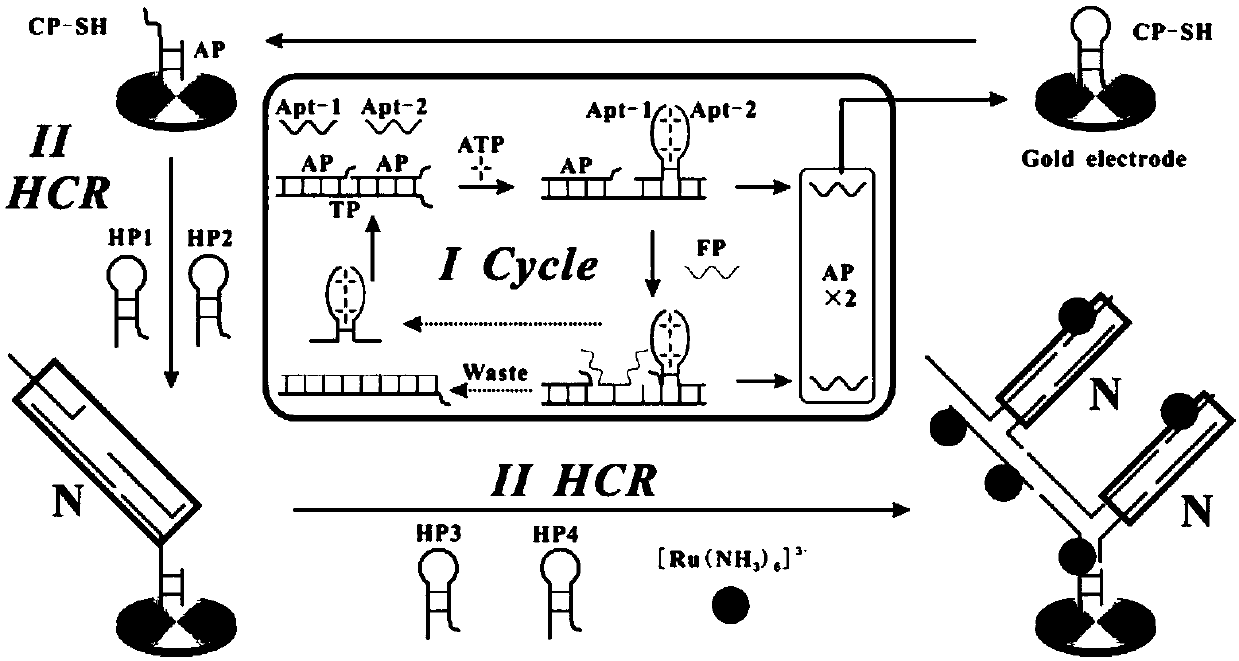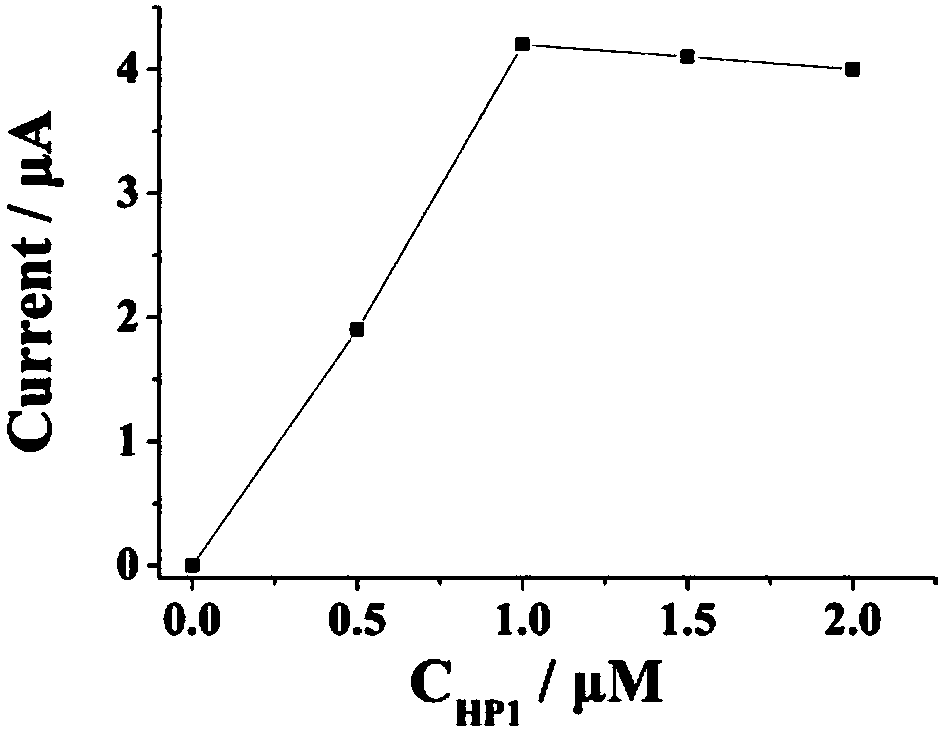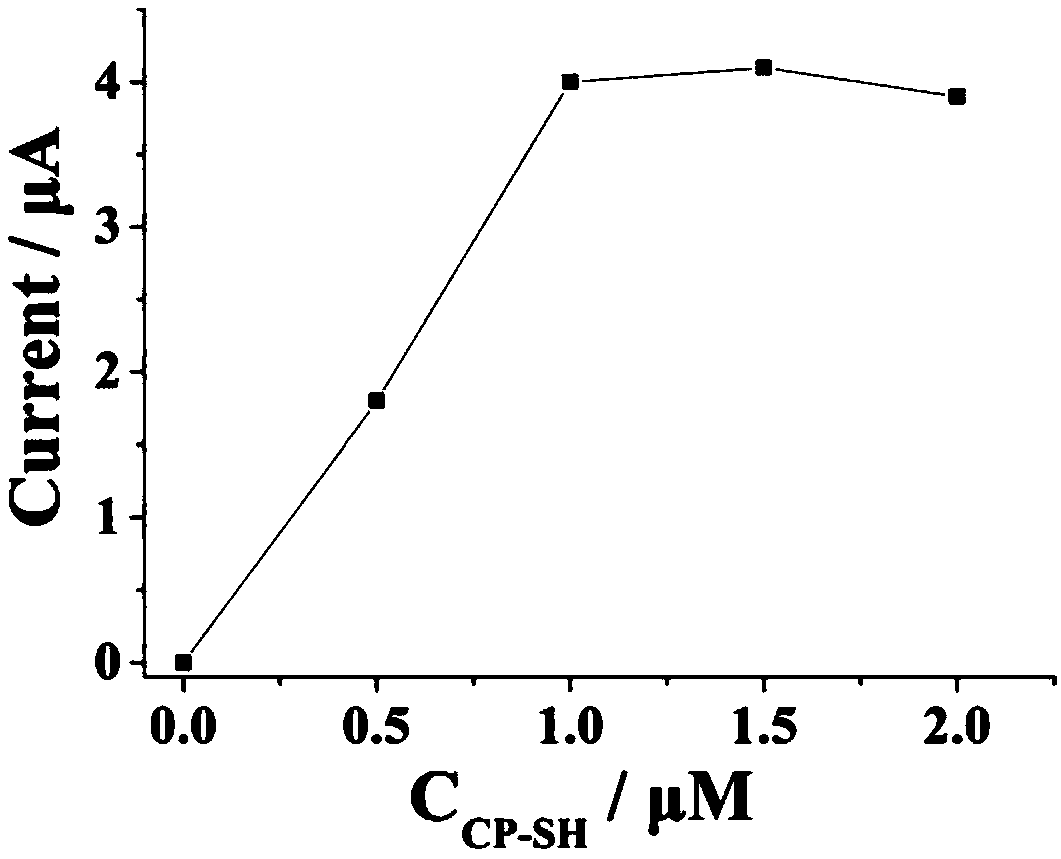Electrochemical sensor for detecting ATP and preparation method thereof
A sensor, electrochemical technology, applied in the direction of material electrochemical variables, scientific instruments, instruments, etc., can solve the problems of high cost, low specificity and sensitivity
- Summary
- Abstract
- Description
- Claims
- Application Information
AI Technical Summary
Problems solved by technology
Method used
Image
Examples
Embodiment 1
[0071] A preparation method of the electrochemical biosensor of the present invention:
[0072] a. The gold electrode is first polished in 0.3 and 0.05 µm alumina slurry until it becomes a mirror surface, and then rinsed repeatedly with PBS and secondary water;
[0073] b. Add 10 μL (0 μM, 0.5 μM, 1 μM, 1.5 μM, 2 μM) of CP-SH onto the electrode surface, incubate at room temperature for 2 h, and wash.
[0074] So far, the modification process of the electrode has come to an end. The following describes the reaction in the homogeneous solution and the main steps in the homogeneous reaction:
[0075] a. Add 1X PBS buffer, 1 μM Apt-1, 1 μM Apt-2, 1 μM AP-TP hybrid double strand, 1 μM FP and 2 μL each of the target to be tested, and 8 μL of sterile water into the centrifuge tube , shaken for 30 s, and incubated in a 37°C incubator for 2 h;
[0076] b. Add the solution (10 μL) after the reaction in step a dropwise onto the electrode modified with CP-SH in advance. Then keep the e...
Embodiment 2
[0085] A preparation method of the electrochemical biosensor of the present invention:
[0086] a. The gold electrode is first polished in 0.3 and 0.05 µm alumina slurry until it becomes a mirror surface, and then rinsed repeatedly with PBS and secondary water;
[0087] b. Add 10 μL of 1 μM CP-SH dropwise to the electrode surface, incubate at room temperature for 2 h, and wash.
[0088] So far, the modification process of the electrode has come to an end. The following describes the reaction in the homogeneous solution and the main steps in the homogeneous reaction:
[0089] a. Add 1X PBS buffer, 1 μM Apt-1, 1 μM Apt-2, 1 μM AP-TP hybrid double strand, 1 μM FP and 2 μL each of the target to be tested, and 8 μL of sterile water into the centrifuge tube , shaken for 30 s, and incubated in a 37°C incubator for 2 h;
[0090] b. Add the solution (10 μL) after the reaction in step a dropwise onto the electrode modified with CP-SH in advance. Then keep the electrode in the incubat...
Embodiment 3
[0099]A preparation method of the electrochemical biosensor of the present invention:
[0100] a. The gold electrode is first polished in 0.3 and 0.05 µm alumina slurry until it becomes a mirror surface, and then rinsed repeatedly with PBS and secondary water;
[0101] b. Add 10 μL of 1 μM CP-SH dropwise to the electrode surface, incubate at room temperature for 2 h, and wash.
[0102] So far, the modification process of the electrode has come to an end. The following describes the reaction in the homogeneous solution and the main steps in the homogeneous reaction:
[0103] a. Mix 1X PBS buffer, 1 μM Apt-1, 1 μM Apt-2, 1 μM AP-TP hybrid double-strand, 1 μM FP and the target to be tested (0 pM, 1 pM, 10 pM, 100 pM, 1 nM, 10 nM, 100 nM, 1 μM, 5 μM) each 2 μL, sterilized water 8 μL were added to the centrifuge tube, shaken for 30 s, and incubated in a 37 °C incubator for 2 h;
[0104] b. Add the solution (10 μL) after the reaction in step a dropwise onto the electrode modified ...
PUM
 Login to View More
Login to View More Abstract
Description
Claims
Application Information
 Login to View More
Login to View More - R&D
- Intellectual Property
- Life Sciences
- Materials
- Tech Scout
- Unparalleled Data Quality
- Higher Quality Content
- 60% Fewer Hallucinations
Browse by: Latest US Patents, China's latest patents, Technical Efficacy Thesaurus, Application Domain, Technology Topic, Popular Technical Reports.
© 2025 PatSnap. All rights reserved.Legal|Privacy policy|Modern Slavery Act Transparency Statement|Sitemap|About US| Contact US: help@patsnap.com



